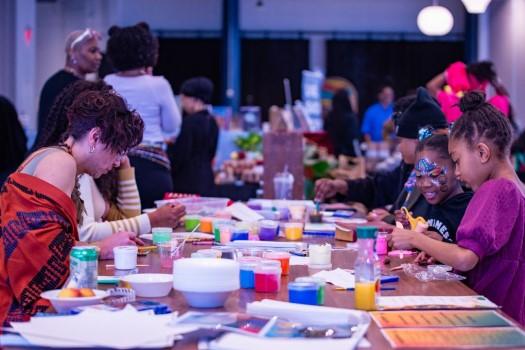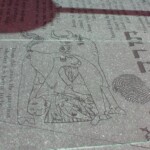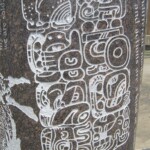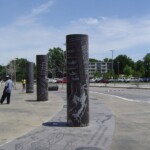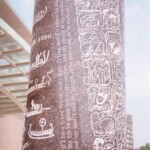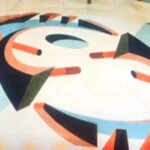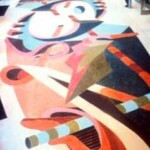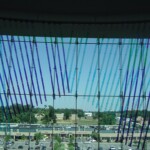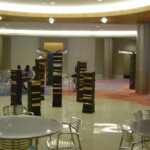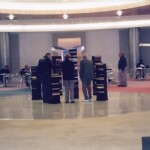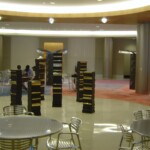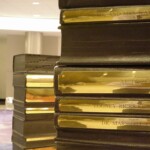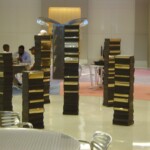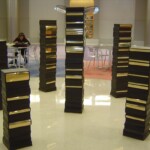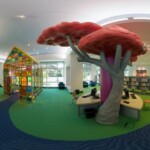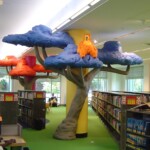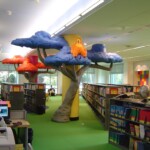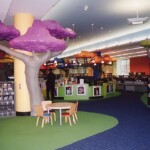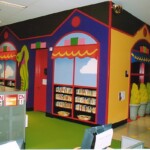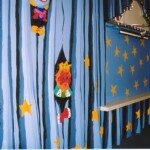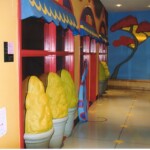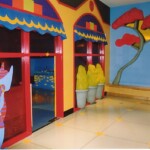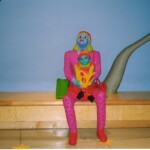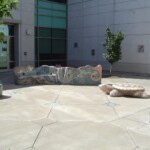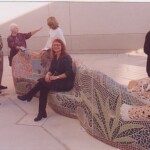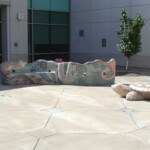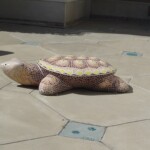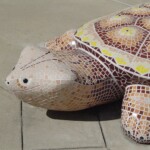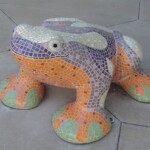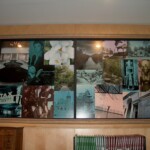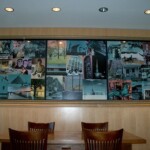CENTRAL LIBRARY ART
“Libraries are no longer just books. They are repositories for knowledge, storehouses of culture, and in the case of the New Central Library, a showcase for art.“
Central Library Public Art Brochure, Library History Collection, Digital ID Library0996.
TO VIEW FULL SCREEN, CLICK HERE.
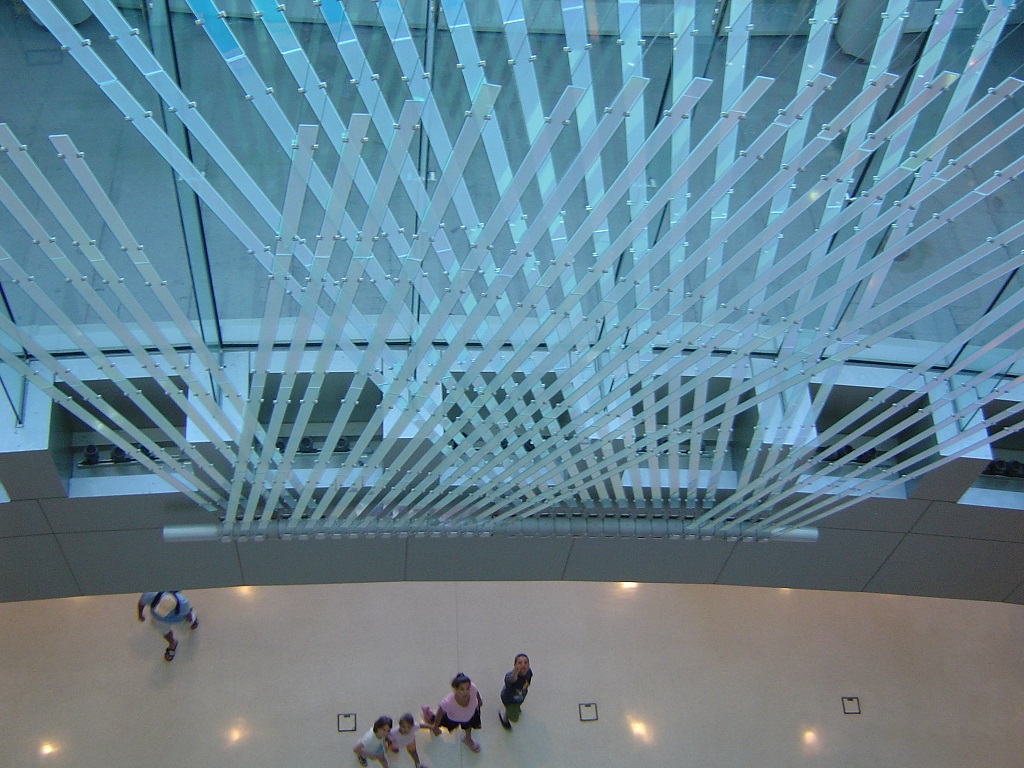
When planning for the new Central Library, a decision was made to incorporate public art into the design and construction of the building. Overseen by the Urban Art Commission, the project settled on 9 public art pieces created by artists from the Mid-South and beyond. Scroll on to read the story behind each piece and see photographs from each installation.
The descriptions here have been pulled from the Central Library Public Art Brochure found on DIG Memphis. The brochure introduces the project by stressing that, “much of the art you will find in the New Central Library is designed to be touched as well as observed. Run a hand over the pillars of knowledge located at the main entrance. Invite your children into the glass house in the Children’s Room. Trace your fingers upon the names engraved on the donor recognition piece in the lobby. It is art to interact with, and even to learn from.”
“Explicitus est Liber” (“The Book is Unrolled”)
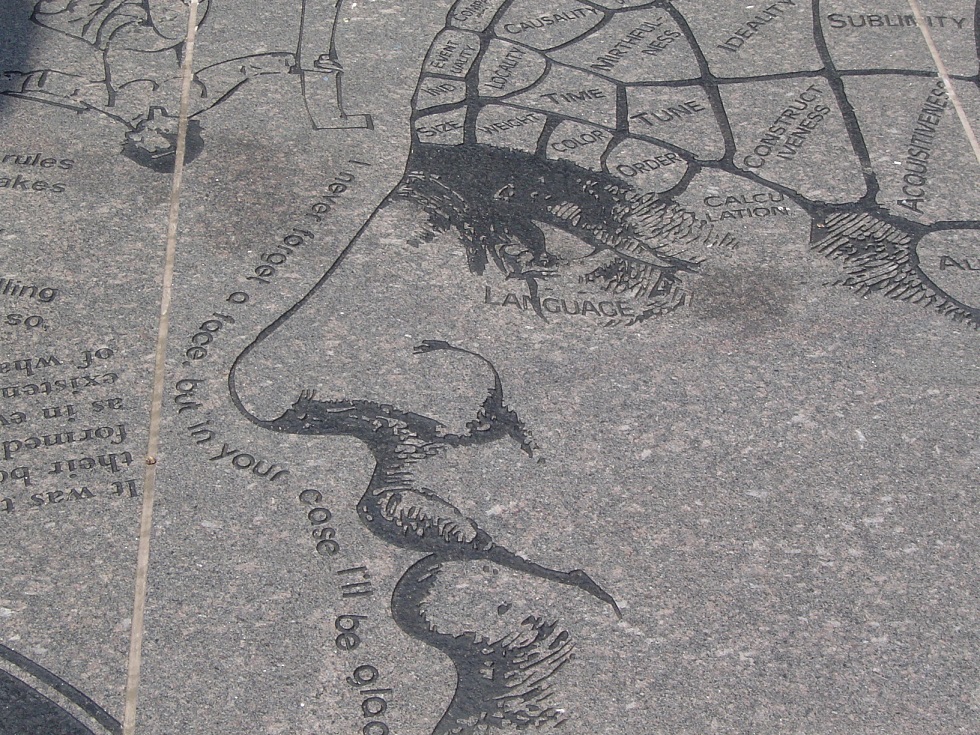
When standing before these pillars, one does not get the impression he or she is studying a work of art so much as a mysterious relic. One left behind by a race far more advanced than ours, with an inside track to mankind’s history and its future.
Goldberg and Roots set out to create a monument in “celebration of the library as a repository of history and culture.” Their goal was was understated as their finished work is so subtly brilliant. Five pillars represent the education of man: from Pillar One – broken in two pieces – that represents humankind’s fragile awakening into discovery, to Pillar Four, whose digitized engravings reflect today’s movement into technology, to the blank face of Pillar Five, leaving the future of the library open to fate. Goldberg and Roots have managed to chronicle the evolution of information in the most profound way imaginable.
Image: Phrenology. Library History Collection, DIG MEMPHIS, Digital ID LC0127.
Artists: Brad Goldberg and Garrison Roots
Medium: Granite
Location: Exterior Walkway – Main Entrance Plaza
Donor: Plough Foundation
For a list of all the works referenced in Explicitus est Liber, check out the Memphis/Shelby Library Public Art Project notes found on DIG Memphis.
About the Artists
Brad Goldberg has worked internationally in countries that include France and Japan. He was honored with the annual Artist/Craftsman Award from the American Institute of Architects.
Garrison Roots was a longtime professor of sculpture at the University of Colorado at Boulder. His acclaimed work is featured at the Denver and Miami International Airports.
The two artists previously collaborated on a massive public art project for the Dallas Convention Center.
“Double Take”
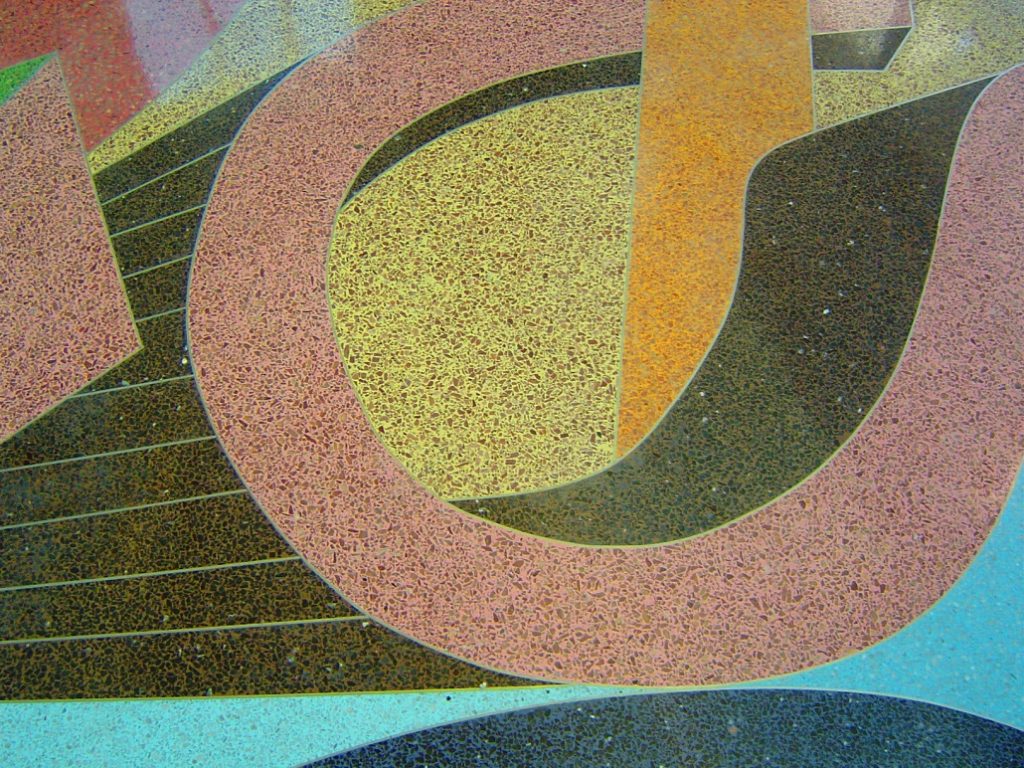
“It makes suggestions without being literal. It is celebratory and very unlibrary-like.”
These are the words of Alonzo Davis, co-creator of the free-form 78×30 foot terrazzo that greets library patrons as they enter the main doors. A non-conforming splatter of color and shape, “Double Take” is a brightly illuminated floor, its bold colors made from crushed marble and a ceiling made of maple wood. Its abstract design alludes to bridges, roads, cables, and buildings, which appears the same whether exiting or entering the library.
Davis and co-creator Pinkney Herbert succeed in making a bold and impressive statement to anyone who happens through the library doors.
Image: Terrazzo floor in Central Library vestibule (3). Library History Collection, DIG MEMPHIS, Digital ID LC0135.
Artists: Alonzo Davis and Pinkney Herbert
Medium: Terrazzo – Crushed Marble & Maplewood
Location: Vestibule Floor
Donor: J. Kevin & Sara Adams and in honor of Kimberly / Wales Blankenship donated by Brent, Preston, Elizabeth & Earl Blankenship
About the Artists
Alonzo Davis was the Dean and Director of Graduate Studies at the Memphis College of Art. His murals and public art include pieces for the Boston Subway in Boston, Massachusetts, a public art commission in the Wolfchase Galleria Mall in Memphis, and a skylight installation at Hartsfield International Airport in Atlanta, Georgia.
Pinkney Herbert taught part-time at the Memphis College of Art. He has exhibited in numerous public and private collections, including the Arkansas Art Center in Little Rock, Arkansas, First Tennessee Bank in Memphis, and the Tennessee State Museum in Nashville, Tennessee.
“Light Veil”

Pratical as it is, we often take for granted the world’s most abundant resource: sunlight. While it is often used as a means to appreciate and accentuate beauty, it has never before been such an awe-inspiring source of beauty. At least, not in the spectacular manner fashioned by architectural artist Ed Carpenter.
Employing his trademark use of large interior surfaces as “light canvasses,” Carpenter’s four-story suspended structure of dichroic glass casts sunlight throughout the lobby. At times, its radiance seems to rival the brilliance of the sun itself, creating a veritable curtain of light. During the evening hours, it is lit to create a rich atmospheric effect that is as engrossing to the eye as it is during the daytime.
Image: Central Library stairway and Light Veil. Library History Collection, DIG MEMPHIS, Digital ID LC0150.
Artist: Ed Carpenter
Medium: Glass
Location: Atrium Staircase
Donor: Kristi and Dean Jernigan and Storage U.S.A.
About the Artist
Ed Carpenter, an architectural artist living in Portland, Oregon, studied architectural glass design in England and Germany on a grant from the Graham Foundation for Advanced Study in the Fine Arts. Since 1972, he has completed more than 40 large-scale collaborative art commissions in public buildings around the United States and Japan. His recent works include a pedestrian bridge in Phoenix, Arizona, two exterior steel and concrete sculptures in Denver, Colorado, and three sculptural glass projects in Japan.
“Diversity”
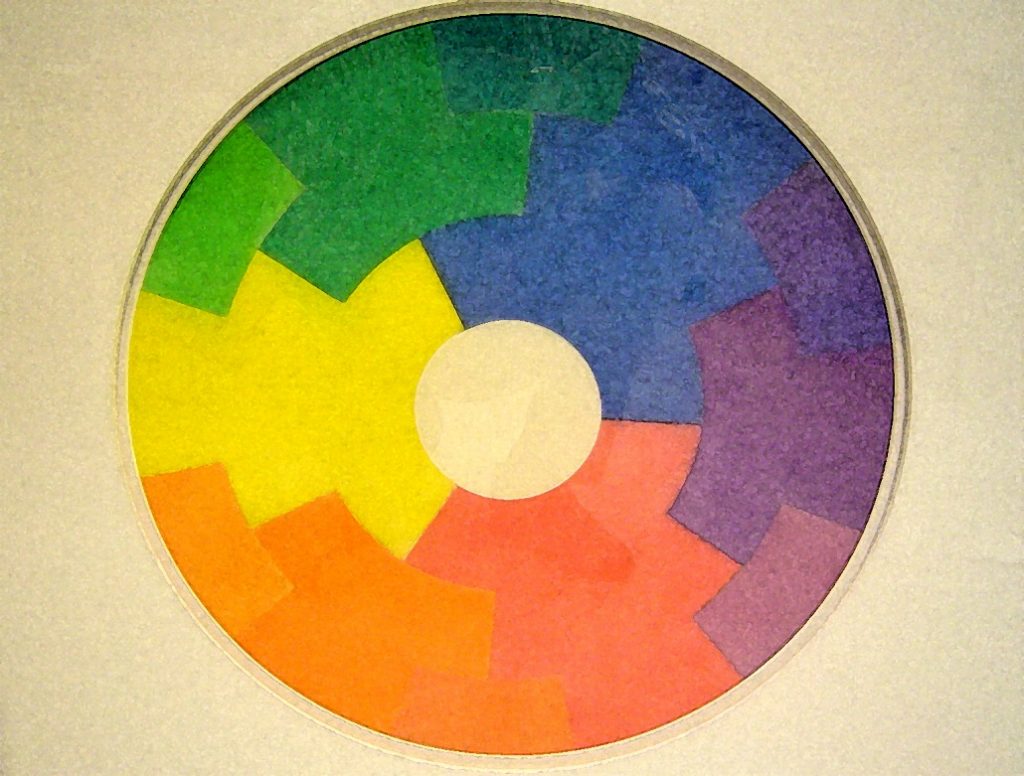
Beware – you may find yourself so transfixed with what is under your feet in the lobby level rotunda that you’ll forget where you’re going. An enormous, handmade wool rug made up of a rainbow of colors, this work draws inspiration from the diversity of our country, the universe – and life itself. Notice how beautifully the colors – regardless of their differences – work together to make a glorious whole.
Based on a dry-color painting originally titled “The One, The Few, The Many,” this extraordinary art is both practical and breathtaking, a work that reminds us what it means to be both singularly unique and part of a greater unity.
Image: “Diversity” by Burton Callicott. Library History Collection, DIG MEMPHIS, Digital ID LC0152.
Artist: Burton Callicott
Medium: Wool Fiber
Location: Lobby Rotunda
Donor: Friends of the Memphis Public Libraries
About the Artist
Born in the Midwest, Burton Callicott is a well-respected Memphis artist who was also a long-time teacher at Memphis College of Art, patiently passing on his intricate techniques to countless generations of student artists.
Callicott continued to create art well into his 90s. His work can be seen locally at the Memphis Brooks Museum of Art, the Pink Palace Museum, and part of the Overton Park Shell.
Donor recognition “wall”
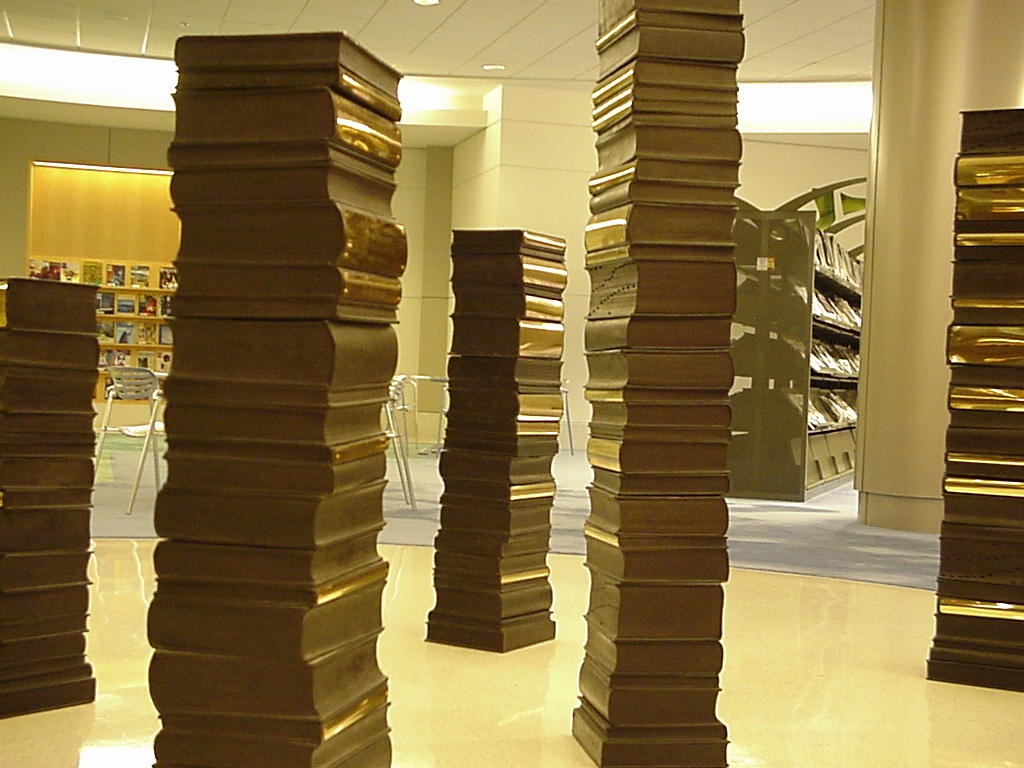
Central Library is an effort created by the will of thousands. From generous corporate donors to the collected nickels and dimes of school children, so many people had their hands in what is one of the finest public libraries in the country.
John Salvest finds a distinctive and iconic means to honor those who made the greatest contributions to the new library fund drive. Imprinted upon an impressive bronze sculpture of stacked books, the names of major contributors to the library are forever immortalized by Salvest’s hearty vision of the library.
Image: Donor Recognition “Wall”, Central Library (2). Library History Collection, DIG MEMPHIS, Digital ID LC0197.
Artist: John Salvest
Medium: Bronze
Location: Lobby Rotunda
Donor: Charles and Evelyn Leonard and in honor of Virginia S. Deyo / donated by Kathy and Dean Deyo
About the Artist
John Salvest is an Associate Professor of Sculpture at Arkansas State University. He has received an NEA Fellowship in Sculpture and a NEA Artist Projects Grant.
“Untitled” – Children’s Department

Perhaps one’s first thought when stepping into the Children’s Area is, “Exactly how did I wander into the pages of a children’s story?”
An understandable reaction, as you are surrounded by stylized trees, colorful rivers and a fantastic glass house at the end of a magical path. Nancy Cheairs has created a world of wonder based on her celebrated painting that grips the imagination of children and adults alike. “I wanted to create a whimsical piece that opens children’s minds to reading and learning,” said the artist. Delightfully exaggerated and fueled by creativity, Cheairs has helped make the Children’s Area of the library the most captivating of its kind.
Image: Glass House in Children’s Department (2). Library History Collection, DIG MEMPHIS, Digital ID LC0164.
Artist: Nancy Cheairs
Medium: A Room-Sized 3-D Rendering Based Upon Paintings by the Artist
Location: Children’s Area
Donor: Jabie and Helen Hardin
About the Artist
Nancy Cheairs is a local artist of wide repute. A native Memphian, Cheairs has exhibited frequently throughout the region and has works in public and private collections including First Tennessee Bank, the Memphis Brooks Museum of Art Promus Hotel Corporation.
“Untitled” STorytelling Room
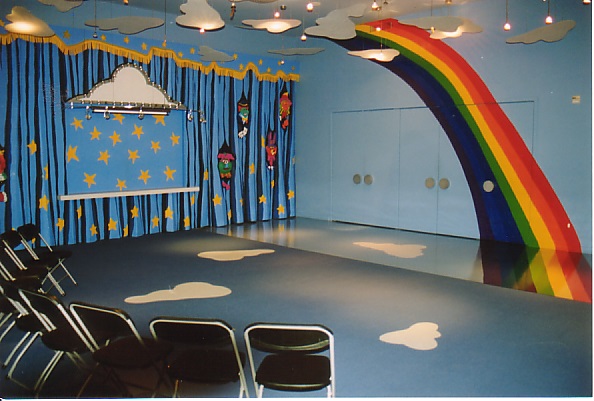
Who told you what the moo cows do? How did you first meet Curious George? Where did you first sing Itsy Bitsy Spider?
Future generations will nostalgically point to Iris Harkavy’s highly imaginative Storytelling Room. Harkavy intended to capture the fun and spirit of children by adorning the ceiling with floating clouds and painting colorful rainbows on the walls. She succeeds admirably, embracing the very essence of childhood. Sculptures of brightly colored animals and people complete an impressive and inspiring place to read, learn, and discover.
What makes this work particularly unique is the unusual way it is seen. Children do not look at the art; instead, they are inside the art itself, surrounded by scenes and creatures only their imaginations can match.
Image: Children’s Department Storytelling Room (3). Library History Collection, DIG MEMPHIS, Digital ID LC0167.
Artist: Iris Harkavy
Medium: A Room of Bright Paints, Plastic Sculptures, and Glass Clouds
Location: Storytelling Room
Donor: Junior League of Memphis
About the Artist
Iris Harkavy is a former social worker who turned to art late in life when, at age 45, she decided to enroll in art school. A 1988 graduate of the Memphis College of Art, Harkavy’s career switch has proved to be a positive one. Her works have been displayed at Memphis galleries such as the Albers Fine Art Gallery and the Alice Bingham Gallery as well as exhibitions such as Arts in the Park. Three of Harkavy’s sculptures are on permanent display in the Wolfchase Galleria Mall in Memphis.
“Rainforest treasures”
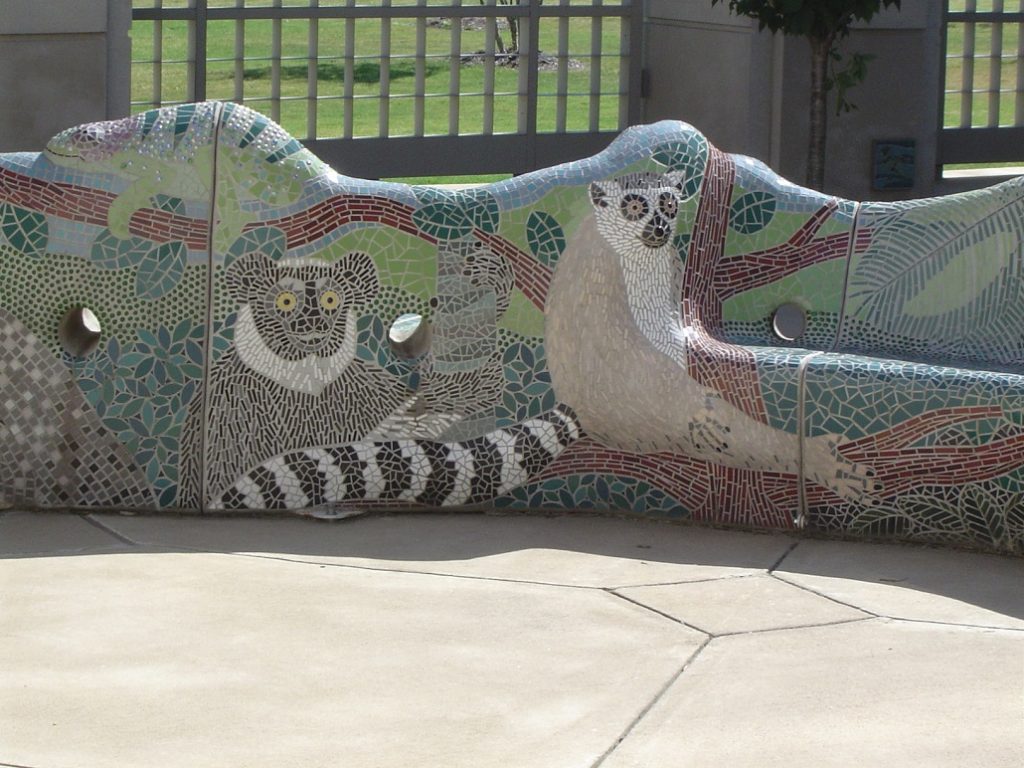
Any cartographer will tell you that Memphis is located in the heart of the Delta, with the mighty Mississippi River to the West and the Smoky Mountains to the East. But unknown to most adventurers – and only recently discovered – is an enchanted rainforest. And it’s located in the heart of Central Library.
Sherri Warner Hunter’s 45×60 foot colorful mosaic celebrates the wildlife of the rainforest. Accented with sculptures of an anteater, giant tortoise, and tree frog, the courtyard transports you to an exotic land of adventure and intrigue. Marching leave-cutter ants and a variety of birds stand in relief on the walls, completing the journey from Memphis to the jungle.
Art that is both functional and decorative, these concrete sculptures, ornamented with intricate, colorful mosaic tiles, virtually call out for touching, climbing, and resting on.
Image: Rainforest Mural. Library History Collection, DIG MEMPHIS, Digital ID L0184.
Artist: Sherri Warner Hunter
Medium: Outdoor Concrete Sculptures and Relief
Location: First Floor Courtyard
Donor: Jabie and Helen Hardin
About the Artist
Sherri Warner Hunter is a sculptor who has been working with concrete for decades. Her large-scale concrete and mosaic public scupltures can be seen at the Nashville International Airport, Tennessee’s State Welcome Center at Tiftonia, and Vanderbilt Children’s Hospital in Nashville. A native of Bell Buckle, Tennessee, Hunter conducts classes and workshops in various concrete and mosaic techniques.
“Poetry. Community. Possibility. History.”

Summing up the essence and history of Memphis is not possible by employing a single image. We are a diverse people; a patchwork quilt of cultures. Understanding the area’s singularities, Jeane Umbreit has created a hand-tinted mural that clearly represents Shelby County, using real-life people and places as her subjects. Umbreit’s murals bring our colorful heritage alive, emphasizing a shared experience of everyday life – Black and white, man and woman, old and young. Her work invites you to explore, question, wonder – and most importantly, dream about a future where all of these elements live together in harmony.
Housed on the fourth floor in the Memphis and Shelby County Room, this piece was placed here because of its shared connection to local history. When it is complete, customers will look up from their work to see – in beautiful, hand-tinted black and white – the people and places they are so diligently researching.
Image: Segment of “Community” by Jeane Umbreit. Library History Collection, DIG MEMPHIS, Digital ID LC0186.
Artist: Jeane Umbreit
Medium: Hand-Tinted Gelatin Silver Prints
Location: Memphis and Shelby County Room
Donor: Links, Inc., Memphis Chapter
About the Artist
Jeane Umbreit is a Memphis-based photographer whose work has been exhibited throughout the United States. Her work can also be found internationally in prominent photography collections such as the Bibliothèque Nationale in Paris.
For a diagram showing all the photographs used in Umbriet’s piece check out the Photo Collage Key found on DIG Memphis.


